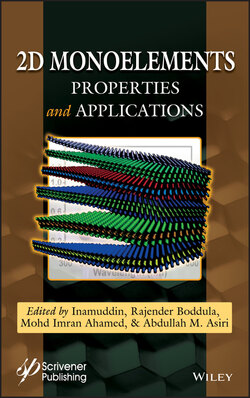Читать книгу 2D Monoelements - Группа авторов - Страница 29
1.3.1.3 Functionalized Phosphorene
ОглавлениеNon-metallic adatoms can also be strongly bound to phosphorene due to the lone electrons pair. Functionalization of phosphorene by adsorption of non-metallic atoms with a [He] core electronic, namely, B, C, N, F, and Al showed different site preferences as schematically illustrated in Figure 1.7. Indeed, while the adatoms B, C, and Al prefer to adsorb to the hollow (H) site, F adatom is adsorbed at the top site and N adatom prefers the bridge one [68]. Furthermore, the chemical functionalization of these non-metallic adatoms exists in three classes [69]. In the first one, the C and B adatoms get located at the interstitial site after breaking the P-P bonds. However in the second group, the N and F atoms remain on the surface of the P atoms and preserve the lattice structure of phosphorene. The last group is formed by the Al impurity, located at the top of the centre of the hexagon. The interatomic distances show that the smaller the adatom, the closer it is to the P monolayer, which implies a higher binding energy compared to the larger ones. This result is confirmed by the calculations of the binding energy (Eb).
Figure 1.7 The three possible adsorption sites.
Figure 1.8 DOS of spin up and down of adatoms.
For B, C, N, F, and Al adatoms on phosphorene, Eb is −5.08, −5.16, −2.98, −2.30, and −3.18 eV, respectively [68, 70]. The adsorption process is more stable in phosphorene since the values of Eb are much greater than the case of adsorbed graphene [71–73]. The higher values of Eb are mainly deserved to the buckled sp3 configuration of the reactive material as reported in [68]. Mid-gap states are observed in the spin-polarized density of states plotted in Figure 1.8 with 1 μB for B, N, and F systems. However, the curves for the C and Al impurities reveal the same number of electrons having up-spin and down-spin, indicating the absence of magnetic order in these configurations [70].
Moving to 3D transition metal (TM), such as Cu, Ti, V, Ni, Cr, and Fe adsorbed at the H site in phosphorene. According to [69], TM adatoms induce a magnetic moment ranging from 1.00 to 4.93 μB. In particular, the Ti adatom states contribute in the midgap and the conduction band (CB), which reduces the band gap to 0.41 eV in the presence of a magnetic order of 1.87 μB [70]. A magnetic of 2.00 μB is observed for Fe adatom systems. In the case of Cr and V adatoms, the spin-down is observed in CB. However, the spin-up of V states dominates the Fermi level and splits into two peaks for Cr adatom. The situation is different for the Ni and Cu adatoms which exhibit no spin-polarization.
